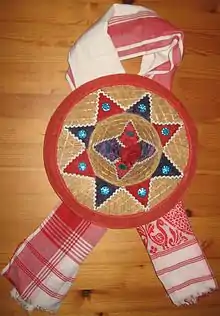Gamosa
The Gamosa ([ɡamʊsa]) is an article of significance for the indigenous people of Assam, India. It is generally a white rectangular piece of cloth with primarily a red border on three sides and red woven motifs on the fourth (in addition to red, other colors are also used). Although cotton yarn is the most common material for making/weaving gamosas, there are special occasion ones made from Pat silk.

A 1,455.3 meter long Gamocha displayed in Delhi created world record as it became world’s longest hand woven piece of cloth.[1]
Origin of the name
Literally translated, it means 'something to wipe the body with' (Ga=body, musa=to wipe) however, interpreting the word gamosa as the body-wiping towel is misleading.[2]
Usage

Though it may be used daily to wipe the body after a bath (an act of purification), the use is not restricted to this.
- It is used to cover the altar at the prayer hall or cover the scriptures. An object of reverence is never placed on the bare ground, but always on a gamusa.
- It is used by the farmer, fishermen or hunter as a waistcloth (tongali) or a loincloth (suriya) or Gamsa; a Bihu dancer wraps it around the head with a fluffy knot (see picture).
- It is hung around the neck at the prayer hall (naamghar) and was thrown over the shoulder in the past to signify social status.
- Guests are welcomed with the offering of a gamusa and tamul (betel nut) and elders are offered gamusas (referred to as bihuwaan in this case) during Bihu.[2]
One can therefore, very well say, that the gamusa symbolizes the indigenous life and culture of Assam.
Cultural significance
Significantly the gamusa is used equally by all irrespective of religious and ethnic backgrounds.
At par with gamusa, there are beautifully woven symbolic clothes with attractive graphic designs being used by different cultural sub-systems and ethno-cultural groups as well.

There were various other symbolic elements and designs traditionally in use, which are now only found in literature, art, sculpture, architecture, etc. or used for only religious purposes (in particular occasions only). The typical designs of Assamese-lion, dragon, flying-lion, etc. were used for symbolizing various purposes and occasions.
In November 2019, the Gamusa published in Geographical indication journal but didn't received the Geographical Indication tag till now.[3]



See also
- Jaapi
- Mekhela chador
- Textiles and dresses of Assam
- Xorai
- Namghar
Notes and references
- Assam Portal. "Assamese Gamusa makes it to the Guinness Book of World Records". the northeast today. Retrieved 31 August 2016.
- "Gamocha". assaminfo.com. Retrieved April 3, 2013.
- Mitra, Naresh. "Assam's Gamosa, Chokuwa rice earn GI tags".
External links
| Wikimedia Commons has media related to Gamosa. |